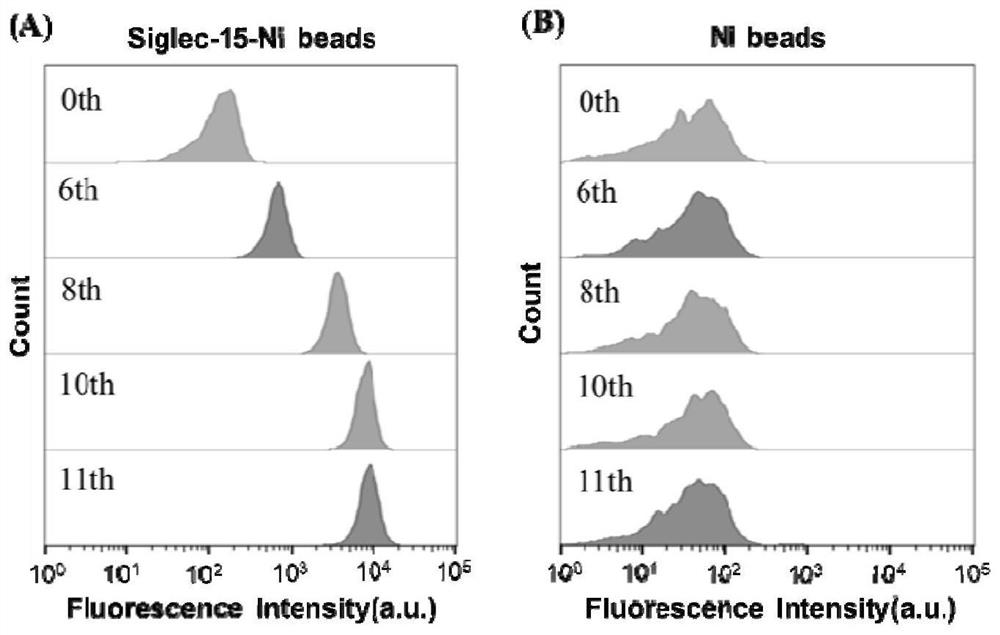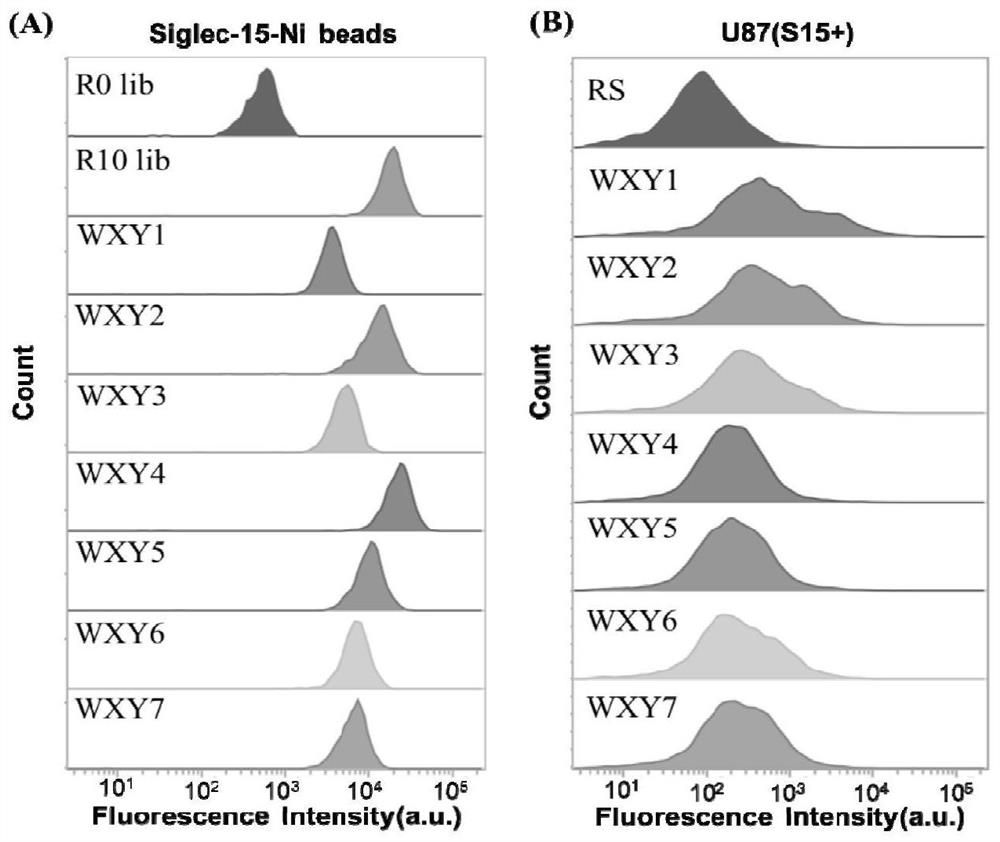Aptamer of sialic acid-binding immunoglobulin-like lectin-15 protein and application thereof
A nucleic acid aptamer and protein technology, applied in biochemical equipment and methods, instruments, analytical materials, etc., can solve the problems of antibody instability, slow antibody production cycle, easy inactivation cost, etc.
- Summary
- Abstract
- Description
- Claims
- Application Information
AI Technical Summary
Problems solved by technology
Method used
Image
Examples
Embodiment 1
[0021] The screening of embodiment 1 Siglec-15 nucleic acid aptamer
[0022] Chemically synthesize an 85-base DNA initial library. The two ends of the DNA initial library are fixed sequences, including a random sequence of 45 bases in the middle, which is 5'-AAGGAGCAGCGTGGAGGATA-45N-TTAGGGTGTGTCGTCGTGGT-3', library capacity for 10 15 above. Take 5nmol DNA initial library dissolved in binding buffer (12mmol / L PBS, pH 7.4, 150mmol / L NaCl, 5mmol / L KCl, 0.55mmol / L MgCl 2 ) for denaturation treatment: 10 minutes at 95°C, 10 minutes on ice, and then 10 minutes at 25°C.
[0023] 2) The recombinant Siglec-15 protein (purchased from Sino Biological) expressed by polyhistidine tag was used as the screening target of the aptamer. Siglec-15 protein is modified on Ni agarose microspheres, and Siglec-15-Ni agarose microspheres are formed by interacting with Ni through the epitope of His-tag.
[0024] 3) The obtained pretreated initial library solution was incubated with Siglec-15-Ni aga...
Embodiment 2
[0027] Example 2 Investigating the Binding Ability and Affinity of Nucleic Aptamers and Siglec-15 by Flow Cytometry
[0028]1) Use His-tag Siglec-15 modified Ni agarose microspheres to monitor the process of enrichment. The results of flow cytometry showed that the fluorescence intensity combined with Siglec-15-Ni-beads increased significantly with the increase of the number of rounds of screening ( figure 1 A), while the fluorescence intensity of Ni-beads did not increase ( figure 1 B), showing that after 11 rounds of screening, the DNA library was successfully enriched with the recognition sequence of Siglec-15 protein.
[0029] 2) Some sequences were obtained by TA clone sequencing of the enriched library, namely WXY1, WXY2, WXY3, WXY4, WXY5, WXY6 and WXY7 shown in SEQ ID NO: 1 to SEQ ID NO: 7 (Table 1). figure 2 A is the initial library, the enrichment library and the combination of 7 nucleic acid aptamers screened out and Siglec-15-Ni agarose microspheres. Although di...
Embodiment 3
[0032] Example 3 Nucleic acid aptamer in Siglec-15 / CD8 + Application of T cell immunotherapy
[0033] 1) CFSE staining CD8 + T detection aptamer pair CD8 + effect on T cell proliferation. Add activated CD8 to Siglec-15 protein + T cells and different nucleic acid aptamers: random sequence, SEQ ID NO: 3 at a final concentration of 2 μM, supplemented every 12 hours. After 72 hours of incubation, the results of flow cytometry showed that compared with only CD8 + T system, add CD8 + After T cells, the activity of T cell proliferation decreased by about 50%, and the nucleic acid aptamer SEQ ID NO: 3 restored the proliferation ability of T cells to a large extent, for only CD8 + 93% of the system of T ( Figure 5 A).
[0034] 2) Use CCK-8 to detect nucleic acid aptamer pair CD8 + The effect of T cells on the killing ability of cancer cells. Add activated CD8 to U87 cells + T cells and different nucleic acid aptamers: random sequence, SEQ ID NO: 3 at a final concentration ...
PUM
 Login to View More
Login to View More Abstract
Description
Claims
Application Information
 Login to View More
Login to View More - R&D
- Intellectual Property
- Life Sciences
- Materials
- Tech Scout
- Unparalleled Data Quality
- Higher Quality Content
- 60% Fewer Hallucinations
Browse by: Latest US Patents, China's latest patents, Technical Efficacy Thesaurus, Application Domain, Technology Topic, Popular Technical Reports.
© 2025 PatSnap. All rights reserved.Legal|Privacy policy|Modern Slavery Act Transparency Statement|Sitemap|About US| Contact US: help@patsnap.com



